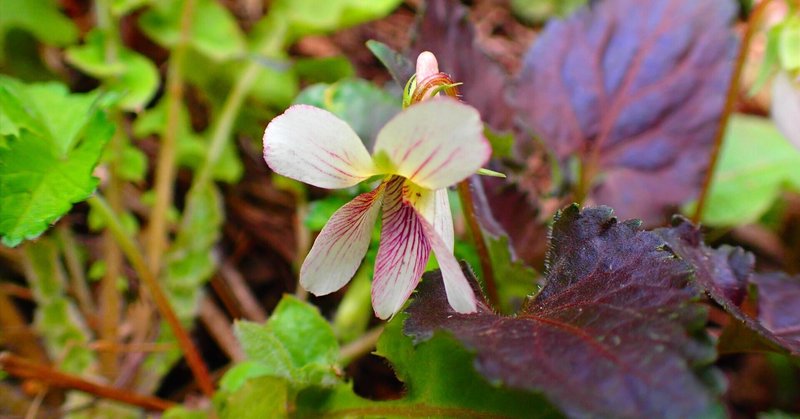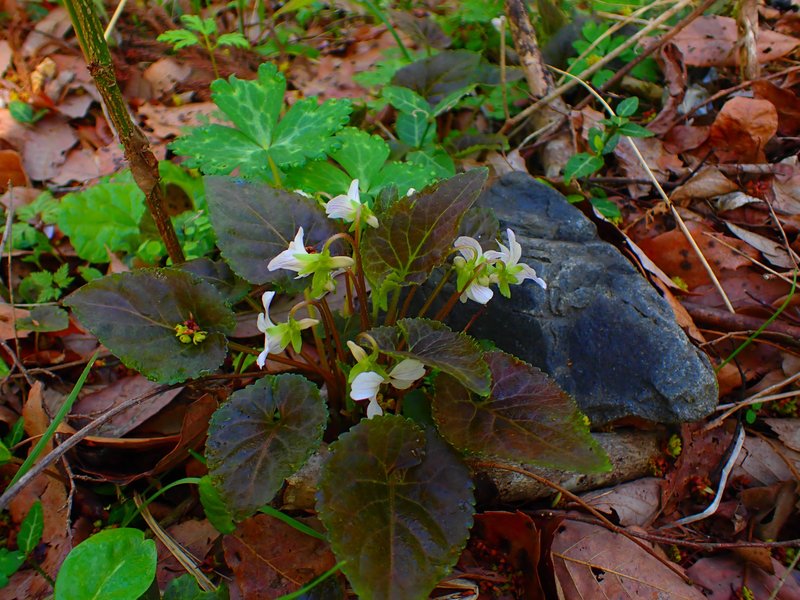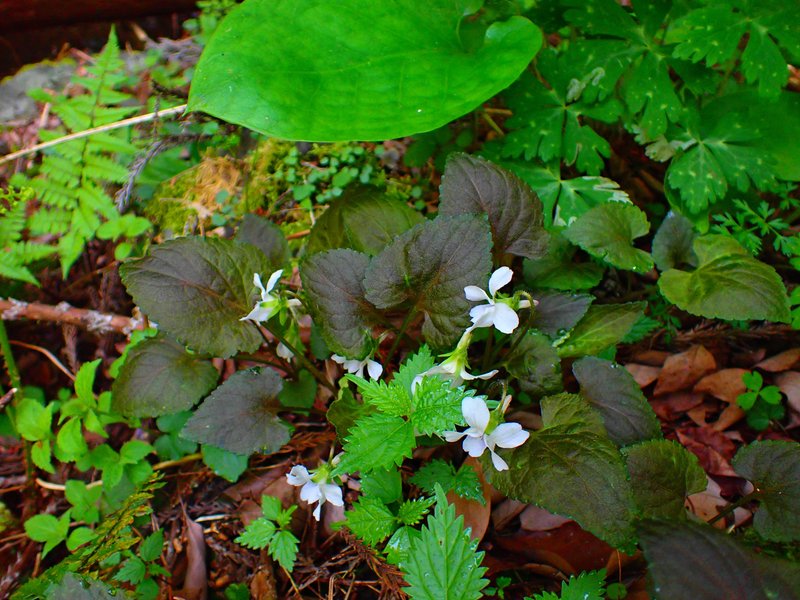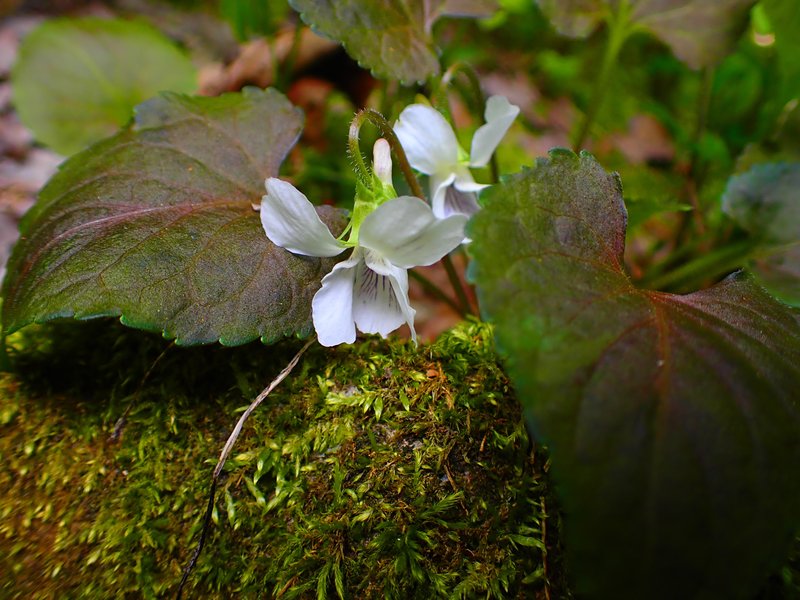
スミレの山 高尾山⑥ タカオスミレ Takao, the mountain of violets: No.6 Takao-sumire
:-:-:-:-:-:-:-:-:-:-:-:-:-:-:-:
高尾山は、知る人ぞ知るスミレの山。
日本では、約50種のスミレの野生種(*1)が確認されていますが、高尾にはそのうち18種が自生している(*2)と言われています。高尾山ならびにその周辺では、毎年3月上旬から5月下旬にかけて、あちこちで可憐なスミレの花々を観察することができます。
Mt. Takao is known as habitats for a wide variety of wild violet flowers (in Japanese, sumire, or “Sue-Mee-Ray”). In Japan, about 50 species of wild violets (*1) have been confirmed, and 18 of them are said to grow naturally in the Mt. Takao area(*2). Every year from the beginning of March to the end of May, you can find pretty violet flowers all over the place in Mt. Takao and its surroundings.
(Stealing and vandalizing wild plants in the areas designated under the Natural Parks Act are illegal and subject to a criminal charge.)
:-:-:-:-:-:-:-:-:-:-:-:-:-:-:-:

This one is typical Takao-sumire, with leaves in dark purple.
タカオスミレは、1928年植物学者中井猛之進博士が高尾で発見し、ヒカゲスミレの変種として発表。そののち、変種ではなくヒカゲスミレの一品種であると改められたものです(学名:Viola yezoensis var. yozoensis f.discolor (Nakai) Hiyama ex F. Maek = 「Nakai」は中井猛之進博士、「Hiyama」は桧山庫三氏)。
Takao-sumire were discovered in Takao by botanist Dr. Takenoshin Nakai, Ph. D., in 1928. They were initially announced as a variant of Hikage-sumire. Subsequently, they were corrected to be the same species as Hikage-sumire with just leaves in different colors. (Scientific name: Viola yezoensis var. yozoensis f.discolor (Nakai) Hiyama ex F. Maek = "Nakai" refers to Dr. Takenoshin Nakai, and "Hiyama” refers to Mr. Kurazo Hiyama).
ヒカゲスミレは葉に鮮やかな緑色から茶褐色ないしは黒紫色まで色違いがあり、また、葉の両面とも濃い色のものや、表側だけ濃いものなど様々な個体が存在します。このうち、葉の両面ともに色の濃いものをタカオスミレと呼びます。高尾で発見されたり、高尾の名を冠した植物は様々ありますが、そのうちのひとつです。
Hikage-sumire have variations in the color of their leaves, ranging from bright green to dark brown or black purple. The color can also be different in each side of of the leaves. Of these, those with darker leaves on both sides are called Takao-sumire. There are various plants found in or named after Takao, and they are one of them.

The one with dark brown leaves
発見当初は、高尾における特有の地理的変異と認識されたのでしょうか。もしかしたら高尾の固有種ではないか、という期待が込められたのでしょうか。事実としては、その後同様の色違いが日本各所で発見され、現在は単なるヒカゲスミレの葉っぱの色違いという結論になっています。
At the time of discovery, was it recognized as a geographical variation unique in Takao? Maybe it was a mere hope that it might be an endemic species of Takao. As a matter of fact, similar color differences were subsequently found in various places in Japan, and the conclusion now is it is simply a discrepancy in the color of the leaves.

The leaves are slightly greenish on this one.
興醒めさせてしまったら申し訳ありませんが、私は科学者側の人間ではありません。高尾出身の地元の者ですので、「単なる色違いですよ」などと無機質な説明をポーカーフェイスで言われるのはがっくりもひとしおです。
I am sorry if I have disappointed you, but I am not on the side of the scientists. I am a local from Takao and sitting on the opposite side. I must say it is such an disappointment to listen to a totally logical speech in apathy with a poker face, ”They are just different in colors.”

Would it just look like Hikage-sumire with a different color?
嘘つきにはなりたくないので固有種の夢は諦めるにしても、そこらじゅうに咲いているわけではなく、見つけるにはそれなりの知識が必要なので、希少な高尾の宝物として大切にしたいと思います。
Well, not that I want to make up a story; I give up on the dream of an endemic species. However, they are not everywhere, and it entails some knowledge and instinct to find them. I would like to cherish them as Takao's precious treasures.
*1
門田裕一,『日本の野生植物 3』, (平凡社、2016), P.209
Yuichi Kadota, "Wild Flowers of Japan 3," (Heibonsha K.K. 2016), P.209
*2
東京都 高尾山ビジターセンター
The Takao Visitor Center
参考文献 Reference
門田裕一,『日本の野生植物 3』, (平凡社、2016), P.218
Yuichi Kadota, "Wild Flowers of Japan 3," (Heibonsha K.K. 2016), P.218
この記事が気に入ったらサポートをしてみませんか?
